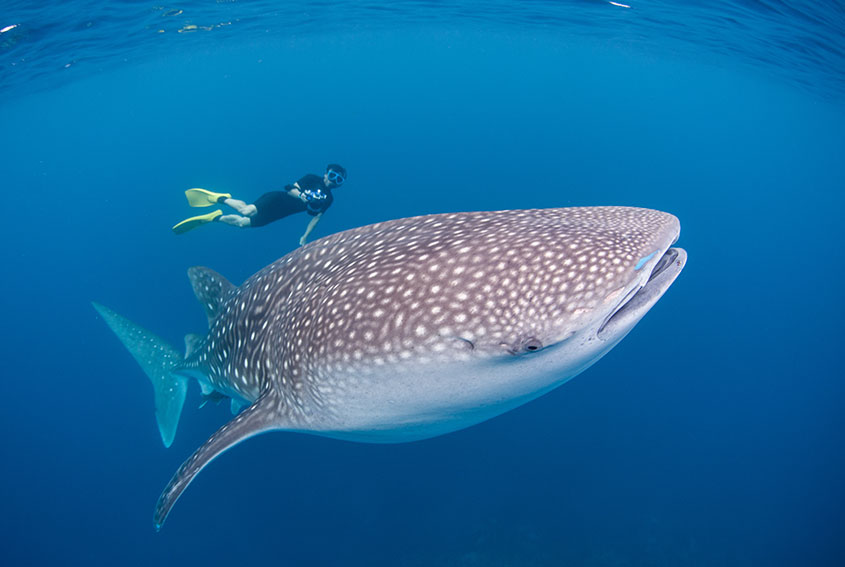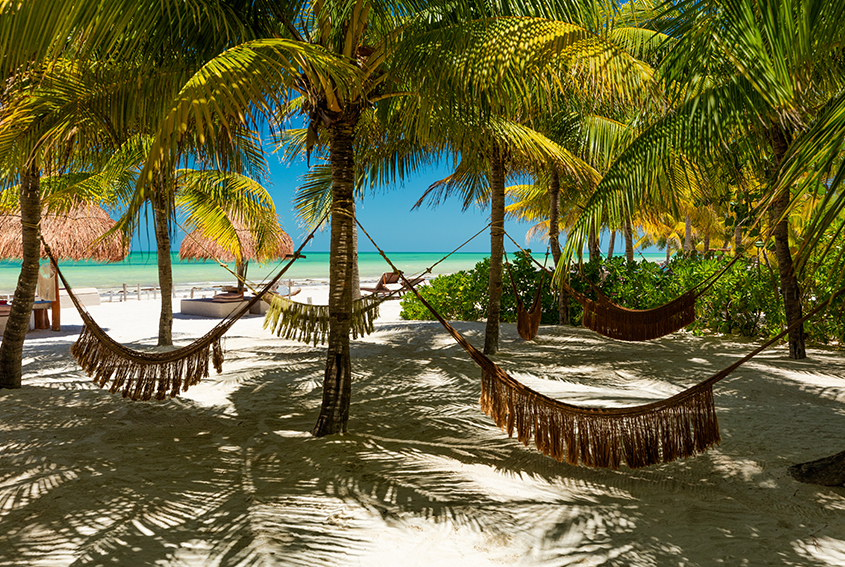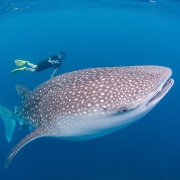This post is also available in:
![]() Spanish
Spanish
If you are traveling to Cancun or Riviera Maya this summer and love the underwater world, how about your own once-in-a-lifetime encounter with nature, an unforgettable swim with the whale sharks, the world’s largest fish. You may have seen these gentle giants in wildlife documentaries, but this is your chance to come face to face with one. From the beginning of June to mid-September, whale shark tours are available in the Mexican Caribbean and Thomas More Travel will take you there.

What draws whale sharks to the Mexican Caribbean?
Whale sharks travel thousands of miles through the tropics in search of the microscopic plankton that is their staple diet. From mid-May to mid-September, they gather in the Mexican Caribbean where higher temperatures cause the plankton to proliferate. Hundreds of whale sharks feast on plankton blooms in the waters off the islands of Holbox, Contoy and Isla Mujeres. Indeed, biologists believe that this is the largest whale shark gathering or aggregation in the world and that it isn’t only plankton that attracts them, but also fish roe. It is the spawning season of a fish called the bonito (little tunny) and researchers have discovered that the whale sharks are partial to the eggs.
There are two whale shark feeding grounds: the area between the island of Holbox and Cabo Catoche, known as the zona verde, an area of upwellings of colder water rich in nutrients where plankton flourishes and the zona azul or zona de afuera, the deeper waters to the east of Contoy and Isla Mujeres, a two-and-a-half-hour boat ride from Cancun. Due to the importance of this area for whale sharks and other marine species such as sailfish, marlin, manta rays, dolphins and sea turtles, the Mexican government declared part of the zone a marine biosphere reserve.
Imagine snorkeling through clear blue waters and watching as a huge creature the size of a bus suddenly appears out of the depths. As the whale shark swims placidly by, its gaping jaws open to scoop up the plankton, you’ll see its markings of spots and stripes, tiny fish busy cleaning parasites from its skin and the ever-present remoras. With a final lazy flick of the tail, it disappears into the distance, leaving you with an incredible sensation of awe and of peace. It is an incredible experience, one that wildlife watchers won’t want to miss.
Each whale shark has a unique set of spots
Local fishermen also call whale sharks “domino” or “pez domino” a reference to their distinctive stripes and blue-grey dappled skin. Each fish has unique markings and taking photos of them is helping whale shark experts around the world to compile a catalog. Using this international database for identification purposes and by tagging sharks and using satellite tracking they can now map the movements of these enigmatic creatures during the year.
A team of scientists based in the Mexican Caribbean and led by marine biologist Rafael de la Parra, has been able to track whale sharks during the year as they swim through the Gulf of Mexico into the Mexican Caribbean and head south to Belize and the Bay Islands in Honduras. One female whale shark from the Gulf of Mexico population was even tracked as far as Brazil, leading the team to christen her “Rio.”
In the Indo-Pacific region, whale sharks gather off the Mozambique coast, the Maldives, Seychelles, Indonesia, Philippines, Australia, Fiji and the Sea of Cortez off Baja California Sur in Mexico.
Eco tours
Guided small group whale shark trips are available from Cancun, Isla Mujeres and Holbox. During the boat ride to the whale shark feeding grounds, your guide will tell you about whale sharks, what is known about their lives and movements, and explain the whale shark rules. You must swim alongside the whale sharks, never in front and keeping a distance of five meters from them. Do not attempt to touch whale sharks and stay away from their tails as they may flick them as they prepare to dive. Only two people per boat plus a guide are allowed in the water at one time. The use of sun products and flash photography are not permitted
During the day, you may spot wild dolphins, sea turtles and the huge manta and mobula rays that join whale sharks to eat plankton. Sometimes the rays breach the water surface in spectacular flight.

Whale shark trips from Holbox
Another option for an unforgettable whale shark adventure is to plan an overnight trip to Holbox, the island of fishermen on the north coast of Quintana Roo. Here, even the wooden signs and colorful murals lining the sandy streets pay tribute to the whale shark. Go in search of whale sharks early in the morning and then enjoy lunch at one of the thatched restaurants on the waterfront. In the afternoon take another boat trip to explore the Yalahau Lagoon and you’ll still have time for the beach, the sunset and to discover the laidback ambiance of the island.
Book your Whale Shark Trip with Thomas More Travel
Call in at the tour desk during your summer vacation to book whale shark trips and Holbox excursions.

